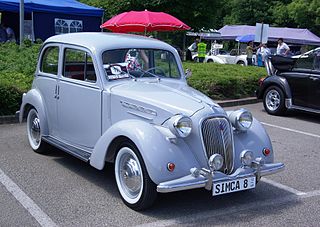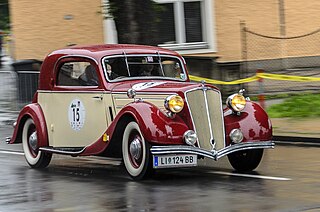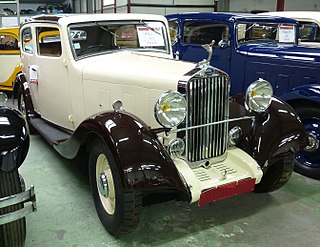
Unic was a French manufacturer founded in 1905, and active as an automobile producer until July 1938. After this the company continued to produce commercial vehicles, retaining its independence for a further fourteen years before being purchased in 1952 by Henri Pigozzi, who was keen to develop Unic as a commercial vehicle arm of the then flourishing Simca business.

The Peugeot 403 is a mid-size car manufactured and marketed by Peugeot between May 1955 and October 1966. A total of 1,214,121 of all types, including commercial models, were produced, making it the first Peugeot to exceed one million in sales.

The Peugeot 203 is a small family car which was produced by the French car manufacturer Peugeot between 1948 and 1960.

The Renault Juvaquatre is a small family car / compact car produced by the French manufacturer Renault between 1937 and 1960, although production stopped or slowed to a trickle during the war years. The Juvaquatre was produced as a sedan/saloon until 1948 when the plant switched its full attention to the new Renault 4CV. During the second half of 1952 the plant restarted production of the Juvaquatre sedans/saloons for a period of approximately five months.

The Simca Aronde is an automobile which was manufactured by the French automaker Simca from 1951 to 1964. It was Simca's first original design, as well as the company's first unibody car. "Aronde" means "swallow" in Old French and it was chosen as the name for the model because Simca's logo at that time was a stylized swallow.

Émile Darl'mat (1892–1970) was the creator and owner of a Peugeot distributor with a car body business established at the rue de l'Université in Paris in 1923. In the 1930s the firm gained prominence as a low volume manufacturer of Peugeot-based sports cars. Business was interrupted by the Second World War, but at least one prototype was kept hidden throughout the period and directly after the war Darl'mat returned to the construction of special bodied Peugeots, although in the impoverished condition of post-war France business never returned to the volumes achieved during the 1930s.

The Simca 8 is a small family car built by Simca and sold in France between November 1937 and 1951, available as a saloon, coupé or cabriolet. It was a rebadged Fiat 508C "nuova Balilla" made at Fiat's Simca plant in Nanterre, France.

The Peugeot 302 is a mid-weight saloon introduced at the 1936 Paris Motor Show by Peugeot and listed, for just 18 months, until April 1938.

The Peugeot 402 is a large family car produced by Peugeot in Sochaux, France, from 1935 to 1942. It was unveiled at the Paris Motor Show in 1935, replacing the Peugeot 401.

The Peugeot 401 was a mid-size model from Peugeot produced in 1934 and 1935. It was introduced at the October 1934 Paris Motor Show and was again on display at the 29th Paris Show of 1935.

The Renault Celtaquatre is a small family car produced by the French manufacturer Renault between 1934 and 1938. Although French, it took some of its styling cues from American cars of the time. Its rounded silhouette gave it the nickname “Celtaboule” ("Celtaball").

The Panhard et Levassor Dynamic is a large car produced by the French auto-maker Panhard et Levassor from 1936 to 1940 as a replacement for the company’s CS. It was introduced at the Paris Motor Show in October 1936.

The Berliet Dauphine is a family car produced by Berliet at their Vénissieux plant on the south side of Lyon between summer 1934 and 1939. The original cars had a 1990cc engine placing them in the 11CV car tax band, but this was quickly joined by a 1,600cc (9CV) version, and at one stage a 14CV powered version was advertised as available “sur commande”.

The Delage D6 is a six-cylinder luxury car produced by the manufacturer between 1930 and 1940 and again, after the war, between 1946 and 1953. For much of this time it was the company’s principal or, from 1946, only model.

The Nervastella is a large automobile constructed by Renault between 1930 and 1937. It was used as a state car and pictures of the president of the French Republic sitting in a Nervastella can therefore be seen in newsreels from the mid-1930s.

The Salmson S4 is a mid-size executive-level car introduced as the Salmson S4 C by Société des Moteurs Salmson in Autumn 1932. It was the manufacturer's principal and often sole model for the next twenty years.

The Delage D4 was a 4-cylinder compact luxury car in the 8CV car tax band produced by the manufacturer between 1933 and 1934.

The Vivaquatre is a car produced by Renault between 1932 and 1939. Its large 4-cylinder engine placed it initially in the 10CV car tax class, though a larger engine later made it a contender in the 11CV class.

The Renault Vivasport was a 6-cylinder engined executive automobile introduced by Renault in September 1933 and produced till April 1935. A larger engined version was produced between December 1934 and February 1938. As with many Renaults during the 1930s, type changes as well as small often cosmetic facelifts and upgrades appeared frequently.

The Panhard CS is a luxury car, most commonly sold with a four-door sedan/saloon body, introduced by Panhard & Levassor at the end of 1929 for the 1930 model year. It was presented as a smaller companion model to the 8-cylinder Panhard DS model. Publicity of the time indicated the "S" in the name stood for "surbaissées"

























